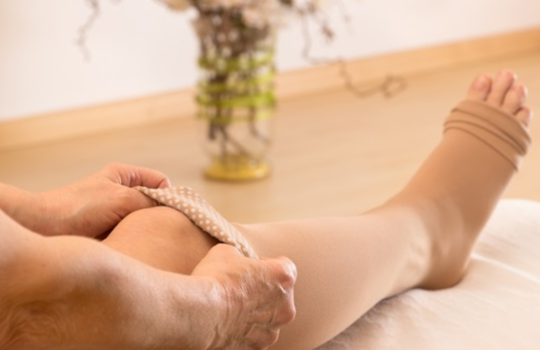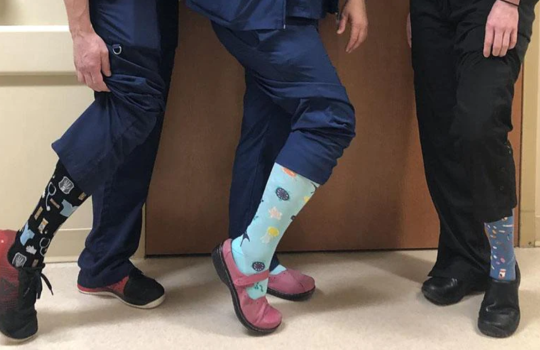Understanding Compression Socks and Compression Sleeves: A Comprehensive Guide

Introduction
Compression garments, such as socks and sleeves, have gained popularity in recent years for their potential health benefits. Whether you’re an athlete looking to enhance your performance or someone seeking relief from circulation issues, understanding the differences and benefits of compression socks and compression sleeves is essential. In this guide, we’ll explore the intricacies of these garments and help you determine which option is best suited for your needs.
What are Compression Socks and Compression Sleeves?
Compression socks and sleeves are specialized clothing designed to exert pressure on specific areas of the body, primarily the legs. This pressure is carefully calibrated to provide therapeutic benefits, ranging from improved blood circulation to reduced swelling and discomfort. Compression garments are constructed using elastic materials that gently squeeze the limbs, creating a graduated pressure gradient that promotes better blood flow.
Interested in copper compression socks for men? Dive into our insightful guide on compression socks for men to learn more about their benefits and options for men compression socks
Benefits of Compression Socks and Compression Sleeves

| Benefits | Compression Socks | Compression Sleeves |
| Enhanced Blood Circulation | Graduated pressure aids blood flow towards the heart. | Promotes blood circulation in the calf area. |
| Reduced Swelling | Helps prevent and alleviate edema by reducing fluid buildup. | Can reduce calf swelling and discomfort. |
| Alleviation of Pain | Eases leg discomfort and achiness by improving circulation. | Offers relief from calf muscle fatigue and soreness. |
| Recovery Support | Aids post-exercise muscle recovery by boosting blood flow. | Assists in muscle recovery after workouts or activities. |
| Management of Chronic Conditions | Beneficial for managing conditions like DVT and varicose veins. | Can help manage conditions like venous insufficiency. |
| Pregnancy Comfort | Relieves leg and foot swelling often experienced during pregnancy. | Offers calf support to pregnant individuals. |
| Travel Comfort | Reduces the risk of blood pooling during long journeys. | Helps prevent calf discomfort during extended travel. |
| Post-Surgery Aid | Facilitates healing and minimizes swelling after surgery. | Assists in reducing calf swelling post-surgery. |
| Athletic Performance Enhancement | Supports circulation during workouts, potentially enhancing performance. | Can improve muscle oxygenation during exercise. |
Who Can Benefit from Wearing Compression Socks or Sleeves?
| Beneficiaries | Compression Socks | Compression Sleeves |
| People with Circulation Issues | Aids circulation in individuals with vascular conditions. | Supports calf circulation for those with poor circulation. |
| Pregnant Women | Reduces leg and foot swelling during pregnancy. | Offers calf support and minimizes swelling in pregnancy. |
| Risk of Deep Vein Thrombosis (DVT) | Prevents clot formation during immobility and recovery. | Reduces DVT risk by promoting blood flow in the calves. |
| Athletes | Enhances performance and recovery by boosting circulation. | Improves muscle oxygenation and recovery for athletes. |
| Varicose Vein Sufferers | Manages symptoms of discomfort and swelling. | Provides relief for those with mild varicose veins. |
| Post-Surgery Recovery | Reduces post-operative swelling and promotes healing. | Assists in minimizing swelling after surgery. |
| Active Individuals | Supports circulation during physical activities. | Aids in muscle recovery and endurance for active individuals. |
| Mild Calf Discomfort or Fatigue | Alleviates calf pain, fatigue, and muscle soreness. | Provides relief from mild calf discomfort and fatigue. |
| Travelers | Prevents blood pooling during long journeys. | Reduces the risk of blood pooling during travel. |
| Lymphedema Management | Aids in managing fluid retention and swelling. | Supports lymphatic fluid drainage in lymphedema. |
| Pregnancy Comfort | Offers calf support and reduces swelling during pregnancy. | Provides calf comfort and relief for pregnant women. |
| Calf Muscle Support | Supports calf muscles after strains or mild injuries. | Provides stability and support for calf muscles. |
Differences Between Compression Socks and Compression Sleeves

When choosing between compression socks and sleeves, consider the following factors:
| Aspects | Compression Socks | Compression Sleeves |
| Coverage | Extend from the foot to the knee or thigh, covering the entire leg. | Cover only the calf area, leaving the foot and knee exposed. |
| Pressure Gradient | Provide graduated pressure, highest at the ankle and decreasing towards the top. | Apply uniform pressure throughout the calf area. |
| Function | Offer compression benefits to the entire leg. | Focus on enhancing circulation in the calf muscles. |
| Use Cases | Suitable for various leg conditions and issues. | Primarily used for calf-related discomfort and circulation. |
| Athletic Performance | Enhance circulation and muscle support for athletes. | Improve muscle oxygenation during physical activities. |
| Medical Conditions | Effective for managing circulation problems and swelling. | Assist in managing mild calf discomfort and fatigue. |
| Post-Surgery Use | Aid in reducing post-operative swelling and promoting healing. | Assist in post-surgery recovery by minimizing calf swelling. |
| Travel Comfort | Help prevent blood pooling during travel or long periods of immobility. | Provide calf support and comfort during travel. |
| Ease of Use | May require more adjustment and fitting due to full leg coverage. | Generally easier to put on and remove. |
| Style and Appearance | Available in various styles, including knee-high and thigh-high options. | Often preferred for its simplicity and discreet look. |
| Wearing with Footwear | Requires compatible footwear due to coverage. | Easily worn with various types of footwear. |
| Layering with Clothing | May require adjustments when worn under clothing. | Easily worn under clothing without adjustments. |
| Specific Focus | Focus on overall leg health, circulation, and support. | Concentrate on calf muscle support and circulation. |
Choosing Between Compression Socks and Compression Sleeves
| Criteria | Compression Socks | Compression Sleeves |
| Full Leg Coverage | Cover the entire leg, offering graduated pressure. | Cover only the calf area, leaving foot and knee exposed. |
| Circulation Issues | Effective for conditions affecting the entire leg. | Primarily suited for calf-related circulation issues. |
| Post-Surgery or Medical Conditions | Suitable for comprehensive support and recovery. | Focus on calf muscle support and localized relief. |
| Athletic Performance and Recovery | Benefit overall leg muscles during and after exercise. | Target calf muscles for enhanced exercise benefits. |
| Calf Muscle Support | Provides support for calf muscles and blood flow. | Concentrates on calf muscle support and circulation. |
| Specific Athletic Activities | Suitable for various athletic activities. | Especially beneficial for activities stressing calf muscles. |
| Travel Comfort | Effective for long journeys to prevent blood pooling. | Ideal for preventing calf discomfort during travel. |
| Layering with Clothing | Requires adjusting under clothing due to coverage. | Easily worn under clothing without adjustments. |
| Ease of Use with Footwear | Requires compatible footwear due to coverage. | Can be worn with various types of footwear. |
| Discreet Appearance | Offers various styles with knee-high and thigh-high options. | Provides a discreet look and pairs well with shorts/skirts. |
| Personal Comfort Preferences | Choose based on overall leg support needs. | Choose for calf-specific support and comfort. |

Conclusion
Both compression socks and compression sleeves provide valuable advantages for individuals aiming to improve circulation, alleviate swelling, and enhance overall comfort. Your selection between these two options relies on the specific area of focus, the type of activities you engage in, and your personal comfort preferences. In instances of uncertainty, seeking guidance from a healthcare professional is advisable. Such experts can provide personalized recommendations according to your medical history and unique needs. It’s essential to note that both options share the common goal of enhancing circulation, offering support, and contributing to an overall sense of well-being. Thus, you have the freedom to choose the one that aligns most fittingly with your lifestyle and objectives.





